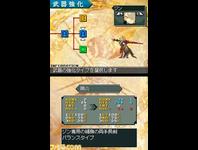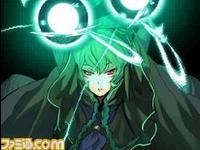|
|

|
PLATFORM
|
DS
|
BATTLE SYSTEM
|

|
INTERACTION
|

|
ORIGINALITY
|

|
STORY
|

|
MUSIC & SOUND
|

|
VISUALS
|

|
CHALLENGE
|
Easy
|
COMPLETION TIME
|
20-40 Hours
|
|
OVERALL

|
+ Fun, interesting tactical combat
+ Customization options that are useful
+ Varied and plentiful side missions
- Will probably never see release outside Japan
- Not much I in the AI
- Timing when attacked must be spot-on
|
Click here for scoring definitions
|
|
|
After Camelot and Sega acrimoniously went their separate ways, the Shining series went through a decade of decline. The original game was remade as Resurrection of the Dark Dragon, but Sega used its ownership of the IP to foist many mediocre action-RPGs onto the market. The Shining name was appended to Soul 1 & Soul 2, Wind, Tears, Force Neo, and Force EXA — all of which failed to please veterans of Camelot's tactical games. In 2009 Flight Plan developed Shining Force Feather, the first new tactical Shining Force game since III on the Saturn — and it stayed in Japan. That might be understandable if the title was a letdown, but Flight Plan has done justice to the series with a game that does not deserve to fall down the memory hole.
Except in III, story has not been the strongest point of the Shining Force series, a tradition that continues in Feather. A treasure hunter named Jin and his friend Bale discover an airship while exploring the world, and manage to ingratiate themselves with its operator, a "Core Unit" named Alfine that looks like a young woman. Their travels in the airship will bring them into contact with numerous others, some of whom will join Jin's team, and eventually the forces of an aggressive empire that has uncovered an ancient mechanism of its own will become the clear antagonists. The names and a few of the details are different, but this plot outline is hardly original, and even importers with no knowledge of Japanese will be able to follow the onscreen happenings in broad strokes.
The old style of Shining Force battles has been swept aside by Flight Plan in favor of a quite effective variant on standard tactical combat. The combatants still take turns, but movement is not tied to a tile-based grid, and an action mechanic is present when physical attacks are made. The lack of a grid makes minute movements matter, and Feather also allows characters to move after taking an action provided they were still capable of doing so.
 If the damage Jin can deal is barely in double-digits, he's in big trouble.
If the damage Jin can deal is barely in double-digits, he's in big trouble.
|
|
When it comes time for a character to take actions, things get interesting. Shining Force Feather uses a gauge on every participant that charges by thirty percent every round or forty if a character does nothing for an entire turn. This gauge will charge to one hundred percent and no further, and is drained by attacking the enemy or using spells. While the gauge naturally recharges over time, its recovery can be improved if the player has good timing when the enemy uses physical attacks, gaining five percent of the gauge back with every correctly timed press when being attacked. It is also possible to recover ten percent (rounded down) of the hit points being lost to enemy attack in the same manner, and either method is an excellent reason to pay close attention when on the defensive. The timing necessary to profit from the enemy's offensives can be very precise, which may dissuade some from making the attempt, but the reward is most definitely worthwhile.
On the offensive, timing still plays a role. Each character has four different attacks that are mapped to each of the DS's face buttons, with more powerful moves learned by gaining levels. Prior to unleashing an attack, the damage output of each move will be displayed. The timing element comes once a character has begun to strike, as a few seconds without launching a new strike will end the encounter. Ending an attack before emptying a character's current gauge is thus possible, as is beating up an enemy corpse just for a higher damage output.
Single combat is not the only way to combat the enemy, however. Shining Force Feather's characters can make a Union, in which the instigator attacks the enemy's front while someone else hits the back, doing somewhat more damage. It is also possible to Connect attacks, letting one character exhaust his or her gauge and then being succeeded by others to chain a lengthy string of strikes. The timing of these actions is not very demanding, but player involvement is mandatory in order to keep them going. Only the casting of spells (which also relies on the gauge being charged sufficiently) is free of any need to react quickly.
 Choose which path his weapon will take!
Choose which path his weapon will take!
|
|
Outside of battle, Shining Force Feather is streamlined and easy to follow even for importers. This unfortunately means there are no towns to visit in the fashion of Camelot's earlier Shining Force games, relegating the function of upgrading equipment to robots inside the airship. Doing so is at least quick and easy, with no hang-ups to confound. Upgrading character weapons is done via several branches, which allow the implement's innate specialties to be adjusted. Also, characters are awarded bonus points for every level gained, and with enough of them a natural magician can be turned into a physical powerhouse, or a slow minotaur can be turned into the fastest member of the team.
Shining Force games are not known for their powerhouse enemy AI, and Feather follows in that tradition. Often some of the enemies will charge at the beginning of a battle, but the ones that do not rush forth will usually stay behind until all their gung-ho friends are defeated. Most of the enemies lack the ability to Unite or Combine their assaults in the manner of the protagonists, though the ones that can do this tend to be dangerous. Even if a character is defeated, this is one of the rare tactical games with means to revive the fallen during battle.
The story battles in Feather tend to rely upon the old staple of killing everything to proceed, but the numerous side missions show a lot of variety. Competing for chests with fellow treasure hunters, protecting chests from a horde of assailants, fighting a tank crewed by goblins that pop out when it is struck, and simply slaying a field of foes within a time limit are all part of the mix. Even the core story doesn't wear out its welcome, since enemy variety is fairly high. The game can probably be completed in twenty-five hours, though extra content is unlocked after finishing the final boss to elicit more gaming time.
 Grizelia is a powerhouse magician, make no mistake.
Grizelia is a powerhouse magician, make no mistake.
|
|
Shining Force Feather manages to have an amazingly high percentage of voice acting to accompany its story sequences, considering the system. Perhaps two-thirds of the central plot has voice acting, and it clearly comes through the DS speakers with generally high-quality performances. The music is a mixed bag, but none of it is outright bad, and certain compositions are quite pleasant. The graphics don't push the DS very hard but do their job quite well, except for the reliance on character portraits against still backgrounds to carry the plot instead of something more kinetic.
Flight Plan may not have made an undisputed masterpiece with Shining Force Feather, but the game is certainly a worthy entry into a series that had been forgettable for years. The probability of it being localized is unfortunately quite low, and this restricts its appeal to those who are willing to wade through a game in Japanese. Feather is not a difficult game to play in another language, however, especially with the DS's region-free property. Anyone who has longed to see a new tactical Shining Force game will not be disappointed.
Review Archives
|









